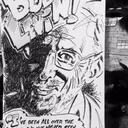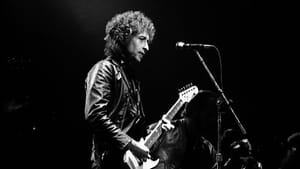Stay in the Loop
BSR publishes on a weekly schedule, with an email newsletter every Wednesday and Thursday morning. There’s no paywall, and subscribing is always free.
On May 3, 1963, a 22-year-old folk singer, down from Greenwich Village, drew 45 people to the Ethical Society for his Philadelphia debut. Less than three years later, he sold out the Academy of Music. In Dylan Goes Electric!, Elijah Wald explains the in-between.
Wald was a six-year-old in Cambridge, Massachusetts when Bob Dylan exploded into “Maggie’s Farm” at the Newport Folk Festival. I was about to start my second year at Penn Law School by moving into a Powelton Village pad, so our connections to those times differ. I might emphasize things differently, but I don’t think Wald missed much. He heard the tapes, he viewed the films, he read the correspondence, he interviewed dozens of people, though Dylan wasn’t one of them. Wald’s reconstruction, from buildup to the set through its consequences, is thoughtful and thorough, balanced and gracefully styled. He lays out facts, voices arguments, analyzes schisms, and answers the enduring questions. Was Bob booed? Were those tears on his cheeks or sweat? Did Pete Seeger threaten his set with an axe? And when the folklorist Alan Lomax wrestled — metaphorically and actually — agent Albert Grossman, who won?
An idealistic communal gathering
Newport’s mix of balladry, bluegrass, gospel, string and jug band, work and protest song, began in 1959. After a minor (no burning, no shooting) riot in 1960, the festival shut down for two years. By 1965, its concerts were attracting 15,000. For some, it was a pre-fall-semester party. For others, Wald writes, it was “an idealistic communal gathering” of whites and blacks, urban people and rural, young and old, “living and behaving and treating each other as members of an optimistic society of equals. . .[demonstrating] camaraderie, moral purpose and distaste for the mainstream commercial pop scene.”
For Wald, Pete Seeger embodied Newport. He had played union halls with Woody Guthrie. He had topped charts with the Weavers. HUAC jailed him, and national TV banned him. It was Seeger’s idea to have “stars” perform for free, and, with the profits their appearances generated, import lesser-known musicians to expand Newport’s audience’s artistic awareness and strengthen its bond with different peoples. For Seeger, “Everything was political.”
The Tramp via Sal Paradise
Dylan was a middle-class Jewish kid from Minnesota who’d hit NYC in 1961, self-wrapped in fibs and mannerisms that soon had him compared to Sal Paradise, Holden Caulfield, Charlie Chaplin’s Tramp, and James Dean’s Jim Stark. While skilled on the harmonica and guitar, his abrasive voice seemed to rule out the possibility of commercial success. But his songwriting, especially when politically wired, caught a cresting mood. Peter, Paul and Mary’s version of one of these, “Blowin’ in the Wind,” hit number one. He was folkdom’s prince.
But the Depression hadn’t forged Dylan or linked him to class struggle. His fight was against 1950s conformity. He was committed to expressing his own vision in his own fashion incorporating all aspects of his world.  By 1965, he had left direct protest behind, replacing it with Rimbaud-inspired imagery of a sort that popular music had never witnessed.
By 1965, he had left direct protest behind, replacing it with Rimbaud-inspired imagery of a sort that popular music had never witnessed.
So when Dylan hit the stage with a black leather jacket, Stratocaster, and five-piece band. . .
Well, you have to remember a few things about America then.
A brief digression for context
First, rock ’n’ roll had no respectability. In the entire Northeast — and, culturally speaking, the Northeast was everything, the South being full of rednecks, the Midwest corn, no one having heard of Boulder or Taos, and California so far away that the coolest guy at one major Pennsylvania university was nicknamed “Coast” because he’d been there — not one deep thinker at the New York Times, New York Review of Books, or Partisan Review took Elvis Presley seriously. No opinion-shaper said anything nice about the Beatles except, maybe, that Paul was cute. Richard Goldstein had not yet legitimized rock criticism in the Village Voice. Crawdaddy, the first serious rock periodical, had not emerged, mimeographed, out of a Swarthmore dorm.
Rock was something we, its first listeners, were expected to grow out of for classical or jazz — or folk. But classical was boring and jazz was hard and folk just didn’t have the numbers Wald thinks it did. The Kingston Trio might sell a zillion albums, but those buyers were more likely to own Take Five or West Side Story than Inside Dave Van Ronk. Philadelphia radio gave folk music two FM hours, Sunday night, which hardly worked if you were roaring down the Schuylkill, several beers to the good, aching for noise. Plus, liking rock stamped you, at most colleges, certainly the best ones, as a C+/B- mediocrity, believing salvation lay in the conventionality-ridden suburbs and that the administration knew what it was doing in Vietnam. Folk was for an elite vanguard of black turtlenecks, mattresses on floors, and tramping futile picket lines.
What Dylan did
Dylan made it okay to like rock ’n’ roll.
He carried the intellectual endorsements to make those who’d disparaged or abandoned rock regard it anew. And he had the genius to make those still-popping fingers rethink rock’s capabilities. Moreover, by moving from the bumper-sticker simplicities of his earlier politics to the equally partisan but more enticingly complex minglings of drug references, put-downs, and psychodrama, he offered anyone siding with him a redefined choice between Hip and Square. And coming as Vietnam and Watts revealed the evil in what we’d been taught was good, and Tim Leary and the Haight exposed the delights that lay in what we’d been told was bad, this was an important choice. The times were a-changing, and who wanted to stand with Mr. Jones?
Wald recounts these developments while noting their cost. Dylan “killed the festival,” Alan Lomax said. He reduced his elders, George Wein said, to “old-time folksingers.” You could grouse, as one Cambridge coffeehouse owner did, that “Hope had been replaced by despair. . .[and] harmony. . .by cacophony.”
Or you might posit, as Wald does, that rock had become “the serious, intelligent voice of a generation.” Rock had united — and advanced — a coalition beyond any that Seeger’s vision could rouse. But what that coalition finally achieved may seem to some only a pale echo of Seeger's dream.
I’ve been a Dylan fan since ’63. I’ve not enjoyed — or been touched by — any other book about him this much.
Above right: the cover of the book, with its copyrighted image.
What, When, Where
Dylan Goes Electric! Newport, Seeger, Dylan, and the Night That Split the Sixties by Elijah Wald. Dey Street Books, 2015. Available at Amazon.
Sign up for our newsletter
All of the week's new articles, all in one place. Sign up for the free weekly BSR newsletters, and don't miss a conversation.

 Bob Levin
Bob Levin
